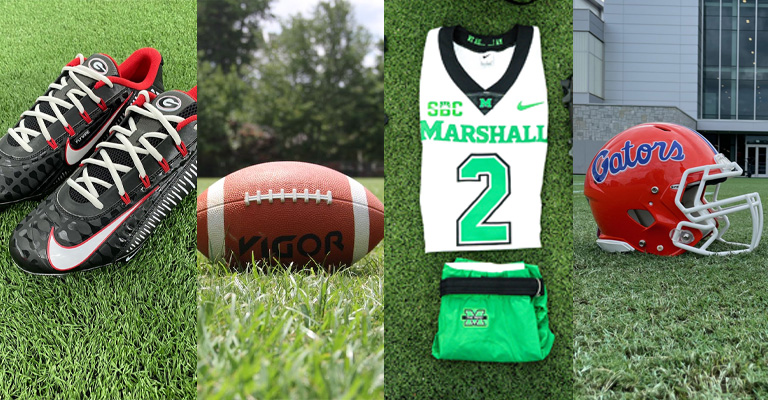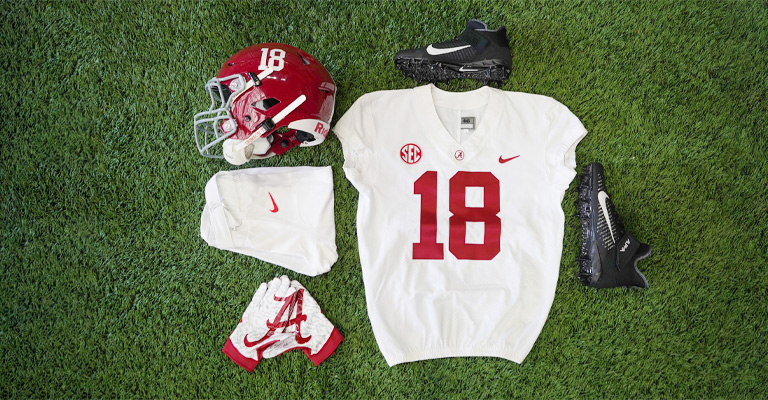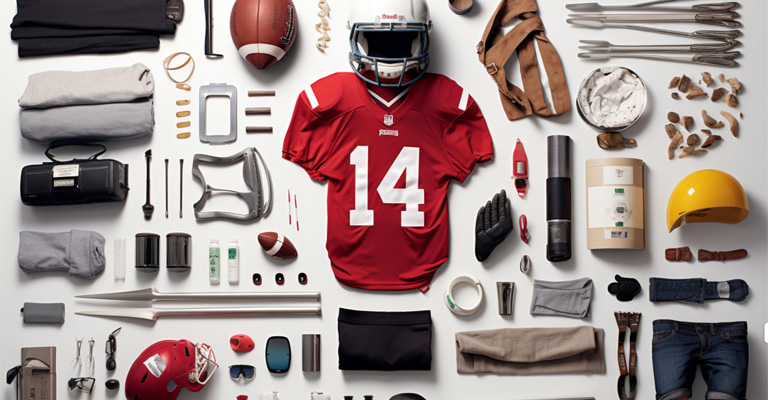Are you ready to step onto the gridiron and dominate the field? Whether you’re a seasoned player or just starting out, having the right football equipment is essential for safety, performance, and overall enjoyment of the game.
From helmets to cleats, shoulder pads to mouthguards, this comprehensive football equipment list has got you covered.
In this guide, we’ll walk you through all the essential gear you’ll need to play football like a pro. We’ll cover the basics, such as helmets and pads, as well as the smaller details that can make a big difference, like gloves and compression wear.
We’ll also discuss the importance of proper fitting and maintenance to ensure your equipment remains in top-notch condition.
So, get ready to suit up and take your game to the next level with our ultimate football equipment list. Let’s dive in and gear up for gridiron glory!
Football Equipment List
Football is a popular sport played worldwide, requiring specific equipment to ensure safety and enhance performance. The essential football equipment includes a helmet, shoulder pads, cleats, and a football.
Helmet
A football helmet is crucial for protecting the head from potential injuries. It is designed with a hard outer shell and a cushioned interior to absorb impact and reduce the risk of concussions.
Shoulder Pads
Shoulder pads provide protection to the upper body, particularly the shoulders and chest. They consist of hard plastic shells and foam padding to absorb and distribute the force of impacts during tackles and collisions.
Cleats
Football cleats are specialized shoes with studs or spikes on the sole. These provide players with better traction on the field, allowing them to make quick cuts, change direction, and maintain stability while running.
Football
The football itself is a vital piece of equipment. It is an oval-shaped ball made of leather or synthetic materials. The ball’s design allows for better grip and control, facilitating accurate passing, catching, and kicking.
Shin Guards
Shin guards are worn to protect the lower legs, specifically the shins, from kicks, tackles, and other impacts. They are typically made of hard plastic or foam and are worn underneath the socks.
Mouthguard
A mouthguard is a crucial piece of protective gear that helps prevent dental injuries and concussions. It is worn over the teeth and gums to absorb and distribute the force of impacts to the jaw and head.
Compression Gear Compression gear, such as compression shorts or tights, is worn to provide support and improve blood circulation during physical activity. It helps reduce muscle fatigue, enhance performance, and aid in recovery.
Gloves
Football gloves are designed to improve grip and control of the ball. They are typically made of tacky materials on the palm and fingers, allowing players to catch and hold onto the ball more effectively, especially in wet or cold conditions.
These accessories provide extra protection and comfort during gameplay. It is important to note that the specific requirements for football equipment may vary depending on the level of play, league regulations, and personal preferences.
Players should always ensure that their equipment meets safety standards and is properly fitted to maximize performance and minimize the risk of injuries.
Girdle
A football girdle is a compression garment that provides additional protection and support to the hips, thighs, and tailbone. It is typically worn underneath the football pants and helps absorb impact during tackles and falls.
Neck Roll
A neck roll is a padded accessory that attaches to the back of the shoulder pads. It provides extra cushioning and support to the neck and helps reduce the risk of neck injuries by limiting excessive head movement.
Visor
A visor is a tinted or clear plastic shield that attaches to the facemask of a football helmet. It helps protect the eyes from glare, sunlight, and potential eye injuries while still allowing for clear vision on the field.
Padded Gloves
Padded gloves are designed with additional padding on the backhand and fingers to provide extra protection against impacts and collisions.
They are particularly useful for players in positions that involve frequent contact, such as linemen and linebackers.
Rib Protector
A rib protector is a padded accessory that attaches to the shoulder pads and provides extra cushioning and protection to the ribs and sides. It helps reduce the risk of rib fractures and other injuries caused by direct hits or tackles.
Football Cleat Accessories
In addition to football cleats, players can also use various accessories to enhance their performance. These include cleat covers, which protect the cleats when not in use, and cleat wrenches, which help tighten or replace cleats for optimal traction.
FIFA Football Equipment Rules

FIFA, the international governing body for football (soccer), has established rules and regulations regarding football equipment. These rules are designed to ensure fairness, safety, and uniformity in the game.
Here are some key equipment rules set by FIFA:
Ball
The ball used in official FIFA matches must be round, made of leather or other approved materials, and have a circumference of 68-70 cm (27-28 inches) and a weight of 410-450 grams (14-16 ounces).
Jersey/Shirt
Players must wear jerseys or shirts that are distinguishable from those of the opposing team and the match officials. The jerseys should have sleeves and numbers on the back, and they must be tucked into the shorts unless designed to be worn outside.
Shorts
Players must wear shorts made of suitable material. The shorts should be the same color as the jersey and must not have any dangerous elements or accessories.
Socks
Players must wear socks that cover their shin guards. The socks should be the same color as the jersey and must not have any dangerous elements or accessories.
Footwear
Players must wear appropriate footwear, typically football boots with studs or blades. The boots should be made of a suitable material and must not have any sharp or dangerous elements.
Shin Guards
Players must wear shin guards made of suitable material and provide a reasonable degree of protection. The shin guards should be covered entirely by the socks.
Goalkeeper Equipment
Goalkeepers are allowed to wear additional protective equipment, such as padded shirts, gloves, and headgear. However, the equipment must not pose a danger to other players.
Jewelry
Players are not allowed to wear any kind of jewelry, including necklaces, bracelets, rings, earrings, or piercings, during the game. Exceptions may be made for medical or religious reasons, but the jewelry must be properly taped or covered.
Headgear
Players are allowed to wear headgear for medical or religious reasons, provided it is made of soft material and does not pose a danger to themselves or other players.
It’s important to note that these rules may vary slightly depending on the competition or league, as FIFA sets the overall guidelines, but individual associations and organizations may have their own specific regulations.
Why Do You Need Football Equipment?

Football equipment is essential for several reasons:
Safety
Football is a physical sport with the potential for collisions and injuries. Proper equipment helps protect players from potential harm.
For example, shin guards protect the lower legs from kicks and tackles, while goalkeeper gloves provide cushioning and grip when diving or catching the ball. Wearing the right equipment reduces the risk of serious injuries and ensures the safety of players.
Injury Prevention
Football equipment is designed to prevent injuries by providing support and stability to different parts of the body.
For instance, football boots with studs or blades offer traction and grip on the playing surface, reducing the likelihood of slipping and twisting an ankle.
Additionally, headgear can provide protection against head injuries, especially for players in positions that involve aerial challenges.
Performance Enhancement
Football equipment can also enhance a player’s performance. For example, football boots are designed to provide optimal traction, allowing players to make quick turns, accelerate, and maintain balance on the field.
Goalkeeper gloves are specifically designed to improve grip and ball control, enabling better saves and distribution.
Compliance with Regulations
Football equipment is necessary to comply with the rules and regulations set by FIFA and other governing bodies.
These regulations ensure fairness and uniformity in the game, as all players are required to wear the appropriate equipment. Failure to comply with these regulations can result in penalties or disqualification.
Identification
Football equipment, such as jerseys with numbers, helps identify players on the field. This is crucial for referees, teammates, and spectators to distinguish between players, especially in fast-paced and crowded situations.
FAQs
Are shin guards mandatory in football?
Yes, shin guards are mandatory in football. They are designed to protect the lower legs from kicks and tackles, reducing the risk of serious injuries. Players must wear shin guards that provide a reasonable degree of protection and ensure they are covered entirely by their socks.
Can players wear jewelry during a football match?
No, players are not allowed to wear any kind of jewelry during a football match. This includes necklaces, bracelets, rings, earrings, or piercings. The prohibition is in place to prevent injuries to both the wearer and other players.
Can goalkeepers wear different-colored jerseys?
Yes, goalkeepers are allowed to wear different colored jerseys from the rest of the team and the match officials. This distinction helps identify the goalkeeper on the field and prevents confusion during the game.
Are there any specific rules for football boots?
Football boots must be appropriate for the playing surface and should not have any sharp or dangerous elements. The boots typically have studs or blades to provide traction and grip on the field. The choice of boots may vary depending on the playing surface.
Can players wear headgear in football?
Yes, players are allowed to wear headgear in football for medical or religious reasons. However, the headgear must be made of soft material and should not pose a danger to the wearer or other players. Headgear can provide additional protection against head injuries.
Bottom Line
With the ultimate football equipment list at your disposal, you can now confidently step onto the field knowing that you have everything you need to excel in the game.
Remember, safety should always be a top priority, so make sure to invest in high-quality gear that fits properly and is well-maintained.
Equipped with a sturdy helmet, protective pads, reliable cleats, and other essential accessories, you’ll be able to focus on your skills and strategy without worrying about your equipment.
Don’t forget to check out our recommendations for additional gear like gloves, mouthguards, and compression wear to enhance your performance and comfort.
So, gear up, hit the field, and let your passion for the game shine through as you tackle, pass, and score your way to victory!







